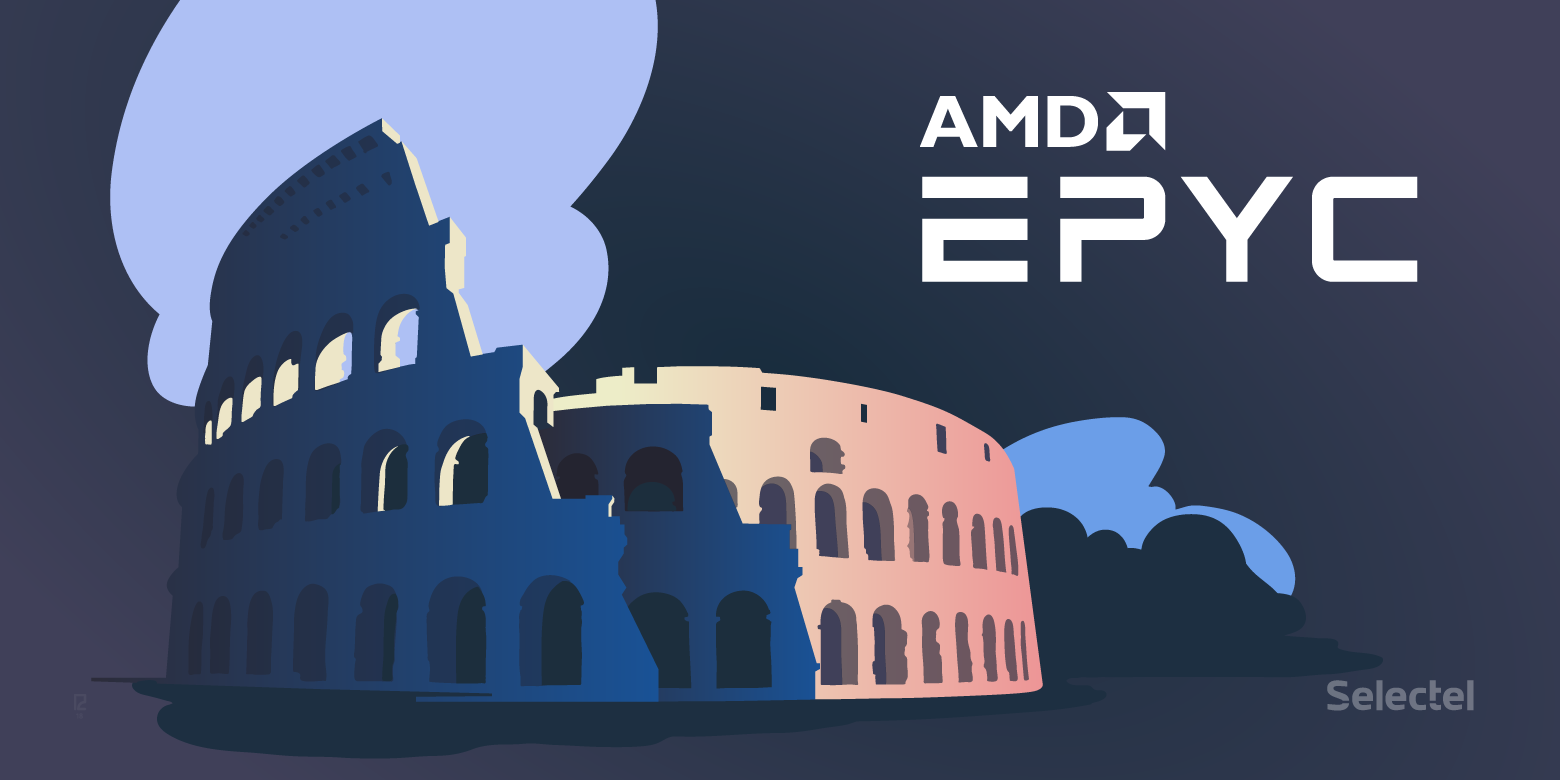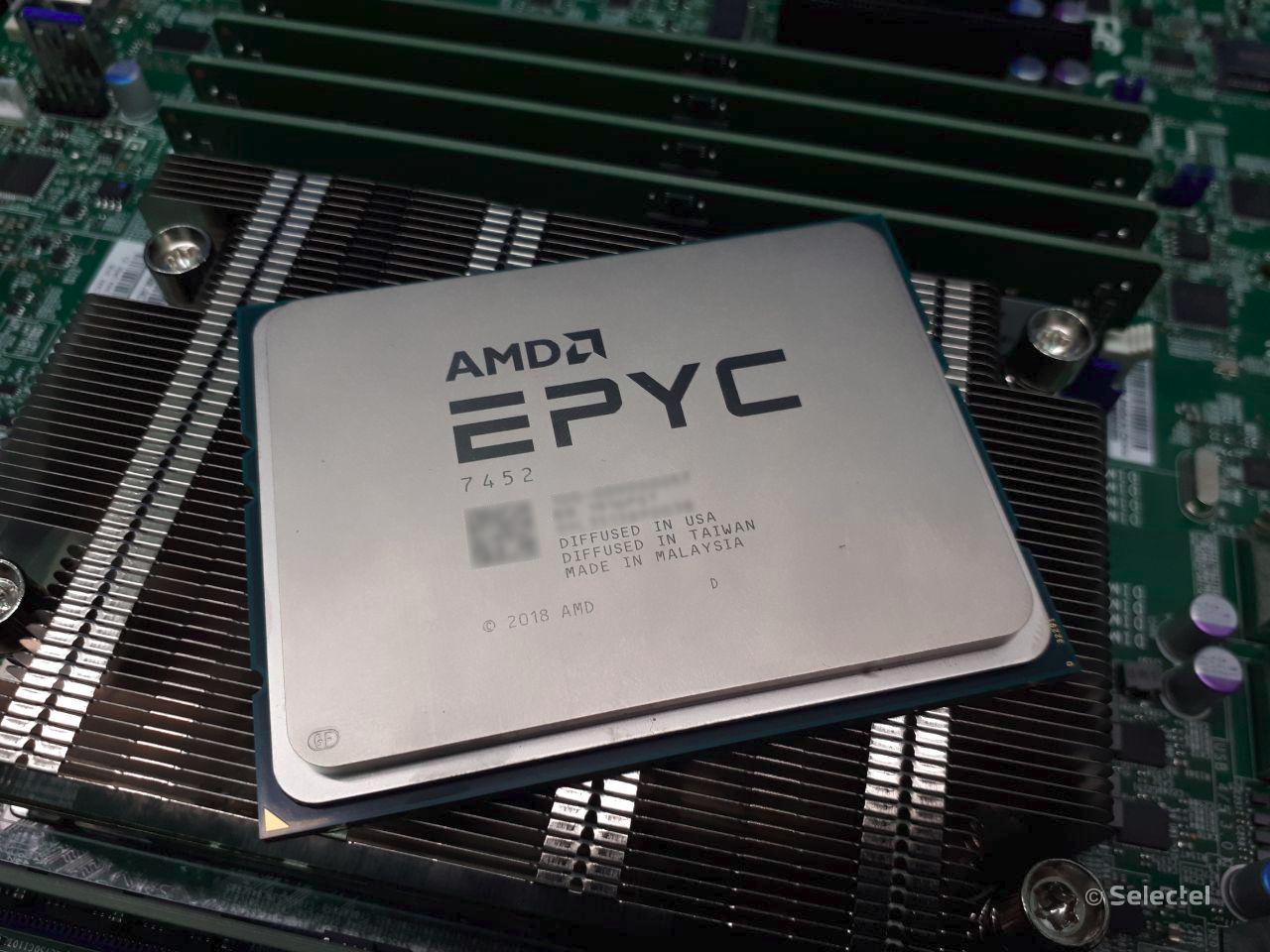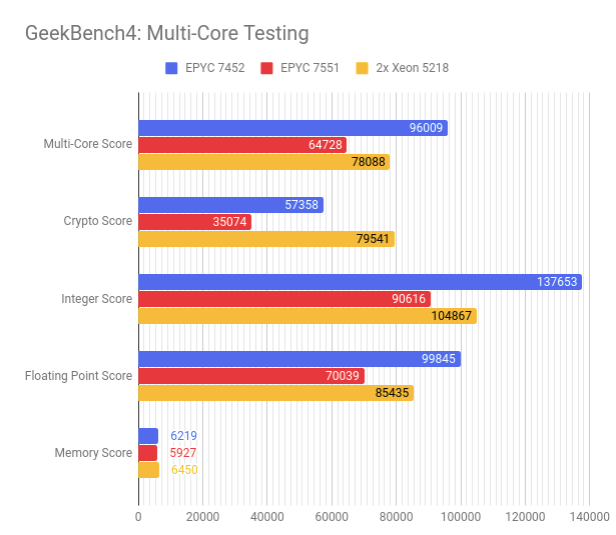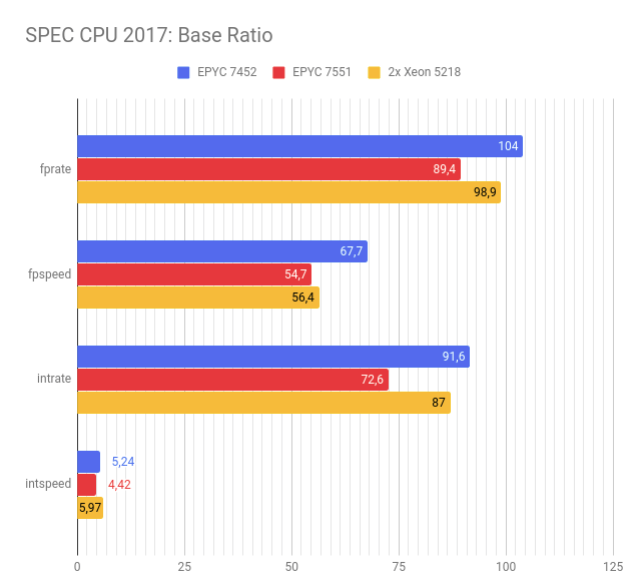Naples to Rome: New AMD EPYC CPUs

On August 7, the second-generation AMD EPYC ™ line was launched worldwide. The new processors are based on the Zen 2 microarchitecture and are built on a 7-nm process.
Features

“They’re greeted by clothes, escorted by the mind,” says folk wisdom. So we will start with the “clothes” of the new generation. The processor markings have undergone minor changes: the fourth digit, representing the generation, has changed from 1 to 2 . The first digit, as before, indicates the series, and the second and third - the model. AMD has not abandoned processors with the P index, which do not support work in multi-socket systems.
The second generation inherited the SP3 socket from the first generation without changes, which allows the use of new processors without updating the motherboard, but this will not be able to fully reveal their potential. Achieving full performance is possible with the use of new motherboards supporting 3200 MHz for DDR4 memory.
The processor "filling" has changed beyond recognition: the technological process has changed, a new Zen 2 microarchitecture has been applied and a new high-speed memory controller has appeared.
Performance
The transition to the 7-nm process led to the compaction of the crystal and an increase in the number of cores to 64 , which is twice as high as in the first generation. The base frequency of the second generation processors is in the range from 2.00 to 2.90 GHz . For comparison, the first-generation base did not exceed 2.30 GHz . An increase in the number of cores and the base frequency of the processor has led to an increase in heat dissipation up to 120 watts in budget versions and up to 225 watts in top versions.
Process improvement is not the only innovation. A new microarchitecture called Zen 2 has contributed to the improvement of processor specifications. Improvements are aimed at interacting with caches: the data exchange speed with L1 has doubled, the data transfer speed between caches has been increased, the size of the L3 cache has been increased.
Detailed specifications of the line are presented in the table.
| Model | TDP, Watt | Number of cores | Base frequency, GHz | Maximum frequency, GHz | Size L3 Cache, MB |
| 7742 | 225 | 64 | 2.25 | 3.40 | 256 |
| 7702 / 7702P | 200 | 64 | 2.00 | 3.35 | 256 |
| 7642 | 225 | 48 | 2.30 | 3.30 | 256 |
| 7552 | 200 | 48 | 2.20 | 3.30 | 192 |
| 7542 | 225 | 32 | 2.90 | 3.40 | 128 |
| 7502 / 7502P | 180 | 32 | 2.50 | 3.35 | 128 |
| 7452 | 155 | 32 | 2.35 | 3.35 | 128 |
| 7402 / 7402P | 180 | 24 | 2.80 | 3.35 | 128 |
| 7352 | 155 | 24 | 2.30 | 3.20 | 128 |
| 7302 / 7302P | 155 | sixteen | 3.00 | 3.30 | 128 |
| 7282 | 120 | sixteen | 2.80 | 3.20 | 64 |
| 7272 | 120 | 12 | 2.90 | 3.20 | 64 |
| 7262 | 155 | eight | 3.20 | 3.40 | 128 |
| 7252 | 120 | eight | 3.10 | 3.20 | 64 |
| 7232P | 120 | eight | 3.10 | 3.20 | 32 |
Increasing capacity and improving conditions for virtualization leads to an increase in the number of simultaneously running applications. Applications work with sensitive data that needs enhanced protection.
Security
In the updated line of processors, security issues were not the last place. Inside the system, a processor is installed on a chip called the AMD Secure Processor based on ARM® Cortex® A5 , which stores keys and encrypts the contents of RAM using the AES-128 algorithm.
AMD Secure Processor offers two types of memory encryption (these methods require OS support):
- SME (Secure Memory Encryption);
SME encrypts memory with a single key and protects against physical attacks such as Cold boot attack. Using this type of encryption does not require changing user applications: the OS marks the memory pages that need to be encrypted.
- SEV (Secure Encrypted Virtualization).
SEV is designed to provide security when working with virtual machines (VMs). The memory used by the hypervisor and each VM is encrypted with its own key. This approach cryptographically isolates the hypervisor and VM from each other.
Test servers
Now that the theory of the new product is known, we will carry out practical tests. AMD EPYC ™ 7452 will be the representative of the second generation. AMD EPYC ™ 7551 is chosen as the opponent from the first generation. The opponent from the “blue” camp is Intel® Xeon® Gold 5218 as part of a two-socket system. The choice of these systems is justified by the similarity of their technical characteristics.
| EPYC 7452 | EPYC 7551 | Xeon 5218 | |
| Number of Cores | 32 | 32 | sixteen |
| Number of threads | 64 | 64 | 32 |
| Base frequency, GHz | 2.35 | 2.00 | 2.30 |
| Maximum frequency, GHz | 3.70 | 3.00 | 3.90 |
| TDP, Watt | 155 | 180 | 125 |
| RAM Type | DDR4-3200 | DDR4-2666 | DDR4-2666 |
| L1 cache, KB | 2048 | 3072 | 1024 |
| L2 cache, KB | 16384 | 16384 | 16384 |
| L3 cache, MB | 128 | 64 | 22 |
In tests, processors are placed on an equal footing: the same memory, the same drives, and identical operating systems with identical settings.
For maximum performance, all channels of the processor's memory controller must be enabled. Intel® processors have six channels, and AMD processors have eight. Given this difference, it is difficult to create identical conditions, so a compromise was found: systems with AMD processors have 8 modules of 16 GB each, and a dual-socket system with Intel® Xeon® has 12 modules of 8 GB each. All RAM modules operate at a frequency of 2666 MHz .
An operating system (OS) is hosted on SSDs to reduce the impact of the disk subsystem on testing. All tests were performed on CentOS version 7.
| EPYC 7452 | EPYC 7551 | Xeon 5218 | |
| Processors | 1 x AMD EPYC 7452 | 1 x AMD EPYC 7551 | 2 x Intel Xeon 5218 |
| RAM | 8 x 16GB DDR4-2666 | 8 x 16GB DDR4-2666 | 12 x 8 GB DDR4-2666 |
| Disks | 1 x Samsung SSD 850 EVO 250GB | 1 x Intel SSD S4510 480 GB | 1 x Intel SSD S4510 480 GB |
Tests
Testing should be as objective as possible, especially since we are talking about comparing Intel® processors and AMD. Therefore, we will not use optimizing compilers to build tests that are supplied as source codes.
GeekBench 4
GeekBench is a popular cross-platform processor performance test with its own online results database . The test comes in the form of ready-made executable files, which is why optimization for specific processors is not provided.
The general metrics of the GeekBench groups are important for us:
- Crypto Score;
- Integer Score;
- Floating Point Score;
- Memory score.
The indicated groups of tests are launched in two modes: in a single thread and when executed simultaneously on all cores. Based on the results, GeekBench puts the final ratings: Single-Core Score and Multi-Core Score .

The main battle is between AMD EPYC ™ 7452 and Intel® Xeon® Gold 5218, while the first generation EPYC ™ is inferior to the second in all tests.
Consider single-threaded tests. Rome shows excellent results when working with cryptographic tasks and memory, but loses when performing integer calculations. As a result, the second generation EPYC ™ scores 4893 points and becomes the winner in the Single-Core nomination. The second and third places are occupied by Xeon and EPYC of the first generation with 4695 and 3981 points respectively.

In multi-threaded tests, the balance of power changes significantly. EPYC ™ 7452 does a great job of computing, but loses ground in cryptographic tasks and working with memory , which does not prevent it from becoming a leader with 96009 points in the Multi-Core nomination.
SPEC CPU 2017
SPEC CPU 2017 is a set of performance tests recognized by processor manufacturers. Tests of this set are distributed in the form of source codes, which allows you to optimize them for specific equipment on a specific operating system.
SPEC CPU consists of four test suites:
- int_rate;
- int_speed;
- fp_rate;
- fp_speed.
The first part in the test name determines the type of computation on the processor: integers (int) or above floating-point numbers (fp). The second part determines the type of testing: single-core (rate) or multi-core (speed).
We conducted all four test suites. Tests are compiled at the third level of optimizations using the GNU 4.8.5 compiler suite. Multi-core tests ran in 64 threads, and single-core tests ran in 32 copies.

Tests compiled with optimizations show inconsistent results with GeekBench. The second generation AMD EPYC ™ is superior to the dual-socket system with Intel® processors in all tests except intspeed, but with a significantly smaller margin than in GeekBench.
Phoronix Test Suite
Phoronix Test Suite (PTS) - software that allows you to run tests from a large database of user performance tests. This solution allows you to automatically run the desired tests on several experimental servers at the same time as aggregating the results on the master server.
We have developed our own set of 21 tests, including:
- Cache Bandwidth Testing (CacheBench);
- testing the bandwidth of RAM (RAMspeed, Stream, MBW);
- cryptographic tasks solution (Botan, OpenSSL, John the Ripper);
- image rendering using ray tracing (C-Ray, POV-Ray, Smallpt);
- emulation of the NGINX server under load;
- audio / video conversion.
| EPYC 7452 | EPYC 7551 | 2 x Xeon 5218 | |
| RAMspeed SMP - Type: Add - Benchmark: Integer | 32476.9 | 26531.49 | 28942.2 |
| RAMspeed SMP - Type: Copy - Benchmark: Integer | 30325.76 | 23419.86 | 27165.75 |
| RAMspeed SMP - Type: Scale - Benchmark: Integer | 30429,76 | 22011.08 | 28629.12 |
| RAMspeed SMP - Type: Triad - Benchmark: Integer | 31482.6 | 18208.58 | 28299.14 |
| RAMspeed SMP - Type: Average - Benchmark: Integer | 31060.8 | 31745.71 | 28432.31 |
| RAMspeed SMP - Type: Add - Benchmark: Floating Point | 32434.26 | 37939.5 | 28445.26 |
| RAMspeed SMP - Type: Copy - Benchmark: Floating Point | 30386.99 | 35209.97 | 27119.9 |
| RAMspeed SMP - Type: Scale - Benchmark: Floating Point | 30,097.11 | 30509.05 | 26508.4 |
| RAMspeed SMP - Type: Triad - Benchmark: Floating Point | 32473.04 | 38458.6 | 28385.89 |
| RAMspeed SMP - Type: Average - Benchmark: Floating Point | 31295.5 | 34393.3 | 27,637.44 |
| Stream - Type: Copy | 107,192.8 | 110,996.94 | 126,257.4 |
| Stream - Type: Scale | 72,434.42 | 87,300.88 | 105633.7 |
| Stream - Type: Triad | 77729,72 | 97735.96 | 115100.86 |
| Stream - Type: Add | 77021.16 | 97,204.36 | 114907.6 |
| MBW - Test: Memory Copy - Array Size: 8192 MiB | 16888.52 | 12,402.32 | 4845.29 |
| MBW - Test: Memory Copy, Fixed Block Size - Array Size: 8192 MiB | 10752.12 | 7410.17 | 2982.56 |
| CacheBench - Test: Read | 2312.41 | 2079.62 | 3286,28 |
| CacheBench - Test: Write | 24357.4 | 20329.21 | 27520.75 |
| CacheBench - Test: Read / Modify / Write | 24920.3 | 21,598.98 | 28966.95 |
| GNU MPC - Multi-Precision Benchmark | 7143 | 5810 | 8950 |
| NAMD - ATPase Simulation - 327,506 Atoms | 0,80079 | 0.94119 | 0.77091 |
| Botan - Test: KASUMI - Encrypt | 69.69 | 61.74 | 78.69 |
| Botan - Test: KASUMI - Decrypt | 67.16 | 58.57 | 74.85 |
| Botan - Test: AES-256 - Encrypt | 4575.94 | 4,173.76 | 3687.71 |
| Botan - Test: AES-256 - Decrypt | 4552.92 | 4152.07 | 3704.3 |
| Botan - Test: Twofish - Encrypt | 279.59 | 247.38 | 325.1 |
| Botan - Test: Twofish - Decrypt | 281.87 | 249.85 | 333.97 |
| Botan - Test: Blowfish - Encrypt | 247.76 | 217.14 | 282.4 |
| Botan - Test: Blowfish - Decrypt | 249.19 | 217.89 | 283.61 |
| Botan - Test: CAST-256 - Encrypt | 116,150 | 101,470 | 124,690 |
| Botan - Test: CAST-256 - Decrypt | 116.68 | 101.95 | 125.75 |
| John The Ripper - Test: Blowfish | 49851 | 40568 | 39555 |
| 7-Zip Compression - Compress Speed Test | 163202 | 107009 | 135458 |
| C-Ray - Total Time - 4K, 16 Rays Per Pixel | 23.41 | 26.65 | 29.48 |
| POV-Ray - Trace Time | 18.67 | 23.3 | 20.46 |
| Smallpt - Global Illumination Renderer; 128 samples | 15.06 | 5.52 | 58.97 |
| dav1d - Video Input: Summer Nature 4K | 17.67 | 28.37 | 20.98 |
| FLAC Audio Encoding - WAV To FLAC | 12.22 | 14.17 | 11.43 |
| FFmpeg - H.264 HD To NTSC DV | 9.14 | 10.85 | 11.46 |
| Hackbench - Count: 1 - Type: Thread | 3.9 | 5.82 | 3.35 |
| Hackbench - Count: 8 - Type: Thread | 10.9 | 18.11 | 8.73 |
| Hackbench - Count: 1 - Type: Process | 3.78 | 5.43 | 3.15 |
| Hackbench - Count: 8 - Type: Process | 9.66 | 13.31 | 8.14 |
| Hackbench - Count: 32 - Type: Process | 39.02 | 32.25 | 27.74 |
| OpenSSL - RSA 4096-bit Performance | 6825.9 | 4351.47 | 6809.23 |
| ctx_clock - Context Switch Time | 211 | 220 | 160 |
| NGINX Benchmark - Static Web Page Serving | 26991.79 | 17497.02 | 28274.97 |
| Schbench - Message Threads: 2 - Workers Per Message Thread: 2 | 42 | 204 | 101 |
| Schbench - Message Threads: 8 - Workers Per Message Thread: 8 | 4624 | 4704 | 7009 |
| Schbench - Message Threads: 32 - Workers Per Message Thread: 32 | 156416 | 157952 | 167509 |
| Radiance Benchmark - Test: Serial | 807,01 | 783.48 | 1102.24 |
| Radiance Benchmark - Test: SMP Parallel | 260.47 | 238.69 | 333.32 |
findings
Despite the variety of tests, the choice between the first and second generation AMD EPYC ™ is obvious: Rome is superior to its predecessor in the vast majority of tests. However, the first generation does not lose ground in working with memory and rendering.
Comparison of Intel® processors and AMD processors - a real battle of the titans, requiring detailed consideration. Installed software solutions perform better on average with the second generation AMD EPYC ™. In particular, Rome shows excellent results in multi-threaded computing and single-threaded cryptographic tasks. When working with software that is compiled from source codes, preference is given to the new generation of EPYC ™ processors, which are leading in floating point tests and only slightly lagging behind in multi-threaded integer calculations.
Intel® Xeon® Gold, in turn, shows good results in multi-threaded cryptography, audio transcoding and memory handling. The dual-socket system with Intel® Xeon® processors performed well when processing web server requests.
To summarize, it should be noted that the tests performed are synthetic and the results on real tasks may vary. To obtain accurate results on specific tasks, additional testing is required. Now just a few words about the cost. The recommended price for AMD EPYC® 7452 is $ 2025, for Intel® Xeon® Gold 5218 - $ 1250, i.e. $ 2500 for a dual-socket system.
The new AMD EPYC ™ 7452 will be available soon at our Selectel Lab.
The second-generation EPYC ™ is just another round in the confrontation between AMD and Intel. You can read more about how the rivalry between the two corporations began in our blog .
All Articles